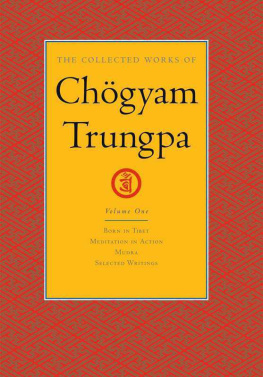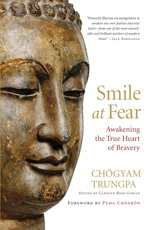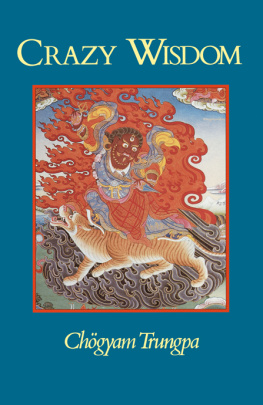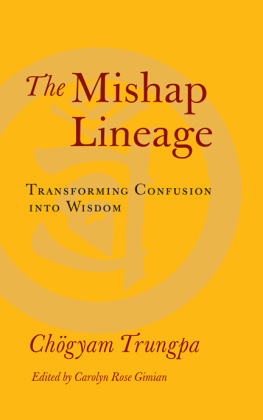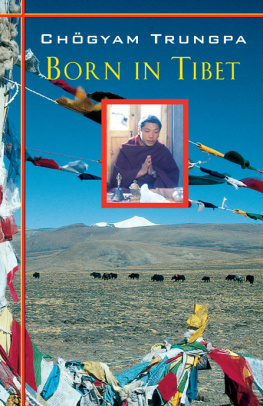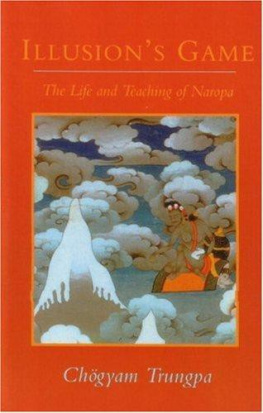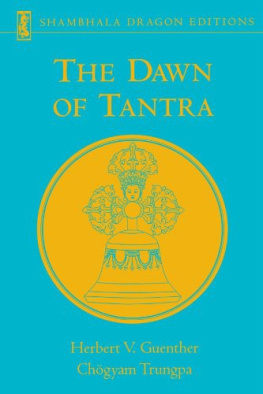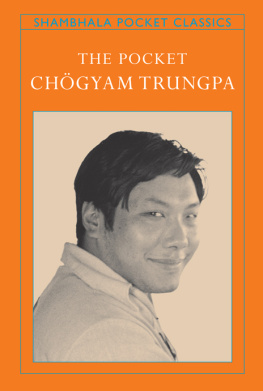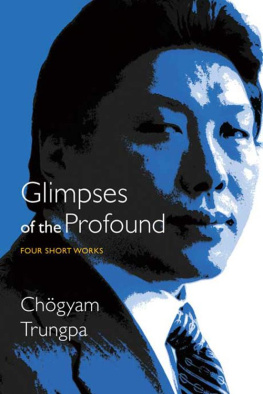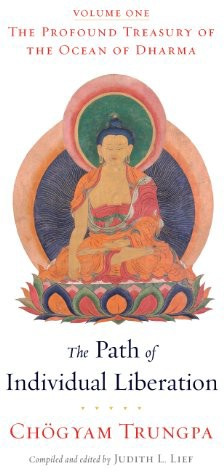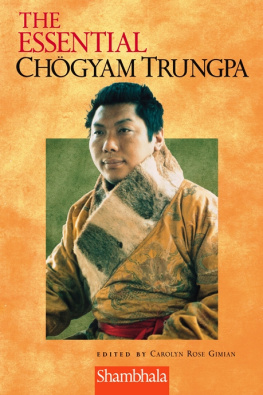
T HE C OLLECTED W ORKS OF C HGYAM T RUNGPA
VOLUME ONE Born in Tibet Meditation in Action Mudra Selected Writings VOLUME TWO Glimpses of Abhidharma Glimpses of Mahayana Glimpses of Shunyata The Path Is the Goal Training the Mind and Cultivating Loving-Kindness Selected Writings VOLUME THREE Cutting Through Spiritual Materialism The Heart of the Buddha The Myth of Freedom Selected Writings VOLUME FOUR The Dawn of Tantra Journey without Goal The Lions Roar An Interview with Chgyam Trungpa VOLUME FIVE Crazy Wisdom Illusions Game The Life of Marpa the Translator (Excerpts) The Rain of Wisdom (Excerpts) The Sadhana of Mahamudra (Excerpts) Selected Writings VOLUME SIX Glimpses of Space Orderly Chaos Secret Beyond Thought The Tibetan Book of the Dead: Commentary Transcending Madness Selected Writings VOLUME SEVEN The Art of Calligraphy (Excerpts) Dharma Art Visual Dharma (Excerpts) Selected Poems Selected Writings VOLUME EIGHT Great Eastern Sun: The Wisdom of Shambhala Shambhala: The Sacred Path of the Warrior Selected Writings
THE COLLECTED WORKS OF
CHGYAM TRUNGPA

VOLUME ONE
Born in Tibet
Meditation in Action
Mudra
Selected Writings
EDITED BY
Carolyn Rose Gimian
FOREWORDS BY
Diana J. Mukpo AND Samuel Bercholz

SHAMBHALA BOSTON & LONDON 2010
Shambhala Publications, Inc.
Horticultural Hall
300 Massachusetts Avenue
Boston, Massachusetts 02115
www.shambhala.com
2003 by Diana J. Mukpo
Publishers Foreword 2003 by Samuel Bercholz
Introduction to Volume One 2003 by Carolyn R. Gimian
See the Sources section at the back of this book for a continuation of the copyright page.
Frontispiece: Chgyam Trungpa in Scotland, circa 1968, provided by Tendzin Parsons. From the collection of the Shambhala Archives. Photographer unknown.
All rights reserved. No part of this book may be reproduced in any form or by any means, electronic or mechanical, including photocopying, recording, or by any information storage and retrieval system, without permission in writing from the publisher.
Library of Congress Cataloging-in-Publication Data
Trungpa, Chgyam, 1939
[Works. 2003]
The collected works of Chgyam Trungpa / edited by Carolyn Rose Gimian; forewords by Diana J. Mukpo and Samuel Bercholz.1st ed.
p. cm.
Includes bibliographical references and index.
eISBN 978-0-8348-2150-7
ISBN 978-1-59030-025-1 (v.1)
ISBN 978-1-59030-026-8 (v.2)
ISBN 978-1-59030-027-5 (v.3)
ISBN 978-1-59030-028-2 (v.4)
ISBN 978-1-59030-029-9 (v.5)
ISBN 978-1-59030-030-5 (v.6)
ISBN 978-1-59030-031-2 (v.7)
ISBN 978-1-59030-032-9 (v.8)
1. Spiritual lifeBuddhism. 2. BuddhismDoctrines. I. Gimian, Carolyn Rose. II. Title.
BQ4302.T7823 2003
294.3420423DC22 2003058963
DEDICATION
Supplications for the Vidyadhara the Venerable Chgyam Trungpa Rinpoche
You who have realized the dharmata of what is,With oceans of skillful deeds of a buddhas son,You possess the buddha activity which tames untamable beings:May your body, speech, and mind be established in the vajra nature.Through the strength of the Buddhas wisdom and compassion and that of his sons far and wide,By the power of the oceans of lokapalas and dharmapalas activity,I ask for the good of the teachings and of beings:May the body, speech, and mind of the glorious guru remain in the vajra nature indestructibly.With the dawn of the blessings of the gurus of the three lineagesYou bring the sun of dharma through the whole expanse of the world;The sight of you ripens and frees, and whatever encounters you is liberated:May the lotus garden of your good virtues beautify the world.
The preceding supplication was made at Karm Chling with one-pointed mind, with veneration and joy, by an old Nyingma tantrika, Gyurme Thekchok Tenpe Gyaltsen [Dilgo Khyentse Rinpoche], who is fortunate to rest under the white umbrella of the buddha activity of the second Buddha, Padmakara. SHUBHAM MANGALAM SHRI VIJAYANTU .
By the power and blessings of the mandala of the universal three roots,May Chkyi Gyatso, the vidyadhara, the tamer of beings,Live and prosper in the vajra nature indestructibly.May your magnificent buddha activity pervade all directions.
Thus, Jigdrel Yeshe Dorje [His Holiness Dudjom Rinpoche] wrote this in supplication for the longevity of the supreme tulku Trungpa Rinpoche. SIDDHIR ASTU .
Translated by the N LAND T RANSLATION C OMMITTEE
CONTENTS
FOREWORD
by D IANA J. M UKPO
M Y LATE HUSBAND , Chgyam Trungpa Rinpoche, was one of the main figures in the transmission of Buddhism to the West, especially to North America. As we know, Buddhism began in India, and from there it spread through many different nations and adapted itself to many cultures. The transplantation of the Buddhist teachings across many cultures and times is proof that, as long as human beings exist, fundamentally the nature of peoples minds does not change. The fundamental issues that we have to deal with as human beings remain the same, as long as people live on this earth. Therefore, the teachings that Trungpa Rinpoche gave will always be applicable, even many years after his death. Therefore, it is of great importance to gather together and publish his teachings. Through The Collected Works of Chgyam Trungpa , people will continue to have access to his mind.
In some respects, Chgyam Trungpas style as a teacher was unorthodox. He dressed in Western clothes and led a life that outwardly was quite secular. He presented the teachings in English and used many colloquial phrases and contemporary examples in his presentation of the dharma. This was very unusual for his time. His life seemed to be a major departure from his monastic upbringing in Tibet. However, interestingly enough, when I traveled back to Surmang Dtsi Tel, his monastery in Tibet, for the first time last summer, it was apparent to me that essentially what he was presenting was very traditional. I felt that there was no fundamental difference in how Buddhism was practiced in Tibet and how it is practiced in the West, in terms of people living their lives according to the dharma and taking the principles of buddhadharma to heart.
Of course, we have a much more complicated and complex society in the West, so the teachings here need to be presented in a different way. My husband understood this. One of the very important ways that he adapted to the West was in his presentation of the Shambhala teachings and his discussion of the concept of creating an enlightened society. These days, most of us dont have the option of going into seclusion in a monastery to practice Buddhism. For most people, these principles have to be applied and effective in our day-to-day lives, how we live our lives each day. Therefore, Rinpoche brought forth the ideas that had been practiced and studied in a monastic context in Tibet and started to show how they can be manifested in society. He developed a broad spectrum of ways to apply the teachings to society in North America. Therefore, while Rinpoche appeared to teach in a nontraditional way, fundamentally the pith of what he taught was very traditional.
One of the hallmarks of Rinpoches way of teaching was to ask students to think for themselves and not to follow anything or anyone with blind faith. The end product was a group of practitioners and students who had tremendous confidence in themselves and in their understanding of the teachings. Rinpoche tried to develop peoples own qualities, rather than asking for blind devotion. He firmly believed that Westerners were capable of practicing and understanding the dharma fully and completely. The irony was that his close students had tremendous devotion to him. Because he never tried to make people purely submit to his will and because he wanted people to develop themselves, they also ended up developing great love and respect for him and immense gratitude for his influence on their lives.
Next page
